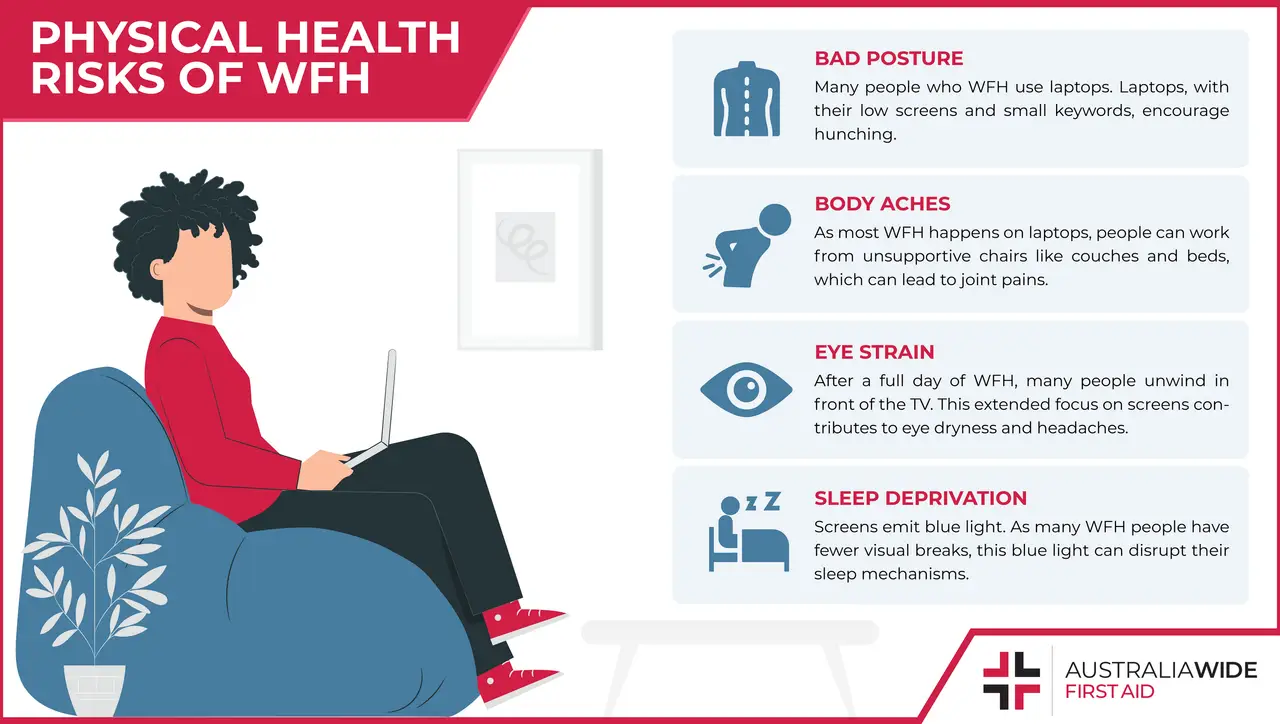Physical Health Risks of Working from Home


Since the beginning of the COVID-19 pandemic in 2020, more people worldwide have been working from home. The increase in makeshift home offices and isolated work environments has seen a rise in various physical health issues.
Although many people, especially in Australia, have returned to the workplace, many still work from home either full time or for part of the week. However, there will be some long-term effects of working from home for so long.
With the increase in work from home since the COVID-19 pandemic, many remote workers found themselves sitting in their chairs all day and maybe getting up to go to the bathroom or kitchen. These rooms are usually just a few steps away.
This sedentary lifestyle causes many physical health issues, including an increased risk of heart disease and diabetes. Finding ways to incorporate walking and exercise into your daily routines is vital.
A little exercise can go a long way. Scientists say that just 15 minutes of intentional exercise daily can help prevent heart disease and other physical health issues. Even if a hardcore workout isn’t possible, simply moving around throughout the day can improve physical health.
Some ways you can prevent physical health issues caused by too much sitting in your work-from-home job include:
After a while into the COVID-19 pandemic, we saw an increase in people purchasing standing desks and desk treadmills. These are also great ways to reduce the time spent sitting and get your body moving while still getting work done.

Working from home is taking a toll on remote workers with increased back pain, body aches, and joint pains. Muscle cramps and body pains are inevitable from not-so ergonomic desk setups, unsupportive chairs, working from couches and beds, and long hours sitting down.
The use of laptops was an essential step in being able to work from home, but they also cause problems.
The low screen and small keyboard encourage you to hunch forward and have unsupported wrists. This can cause issues with postures and even repetitive strain injuries in the hands. Laptops also encourage people to work around the house, such as from bed, rather than a proper desk.
Some ways you can prevent bad posture, aches and pains caused by working from home or using a laptop all day include:
While it also happens in the office, it’s a lot easier to fall into a pattern of bad posture and sitting for long periods when working from home. Makeshift workstations can cause huge posture and muscle problems, with extended hours spent in unsupported positions that put the body, in particular the spine, under strain.
Face-to-face meetings are happening via Zoom, people send emails instead of walking over to their coworkers, and we're eating lunch in front of our screens. Once we finish work for the day, we continue to use screens to unwind and watch Netflix or scroll through social media.
Everything we are doing is on a screen these days, so there are fewer visual breaks. These screen habits can lead to physical health issues such as eye strain, headaches, and interruption to our sleep, causing sleep deprivation.
Extended focus on screens greatly contributes to people working from home experiencing increased eye strain. And then, among other things, eye strain can lead to many people's long-term issues, eye dryness and headaches.
Another contributor to eye strain that can cause a lack of sleep is the blue light emitted from screens. This disrupts your vision, and if you're on screens too close to bedtime, it disrupts the sleeping mechanisms in your brain.
Some ways you can prevent eye strain caused by too much screen time in your work-from-home job include:
If your screen time and remote working lifestyle have caused you to become sleep deprived, you can check out some tips for better sleep to get you back on track.
Remote working can increase the risk of certain physical health issues. Many of these issues can be prevented or alleviated by taking some steps to improve your work-from-home environment and new lifestyle.
You can also attend a first aid course, so you know how to identify, prevent and manage physical injuries due to increased work from home.

October 1, 2024
Almost every job involves using the body to carry out some type of manual task. Some tasks may be hazardous, causing injuries such as musculoskeletal disorders (MSDs). Knowing how to manage them is a legal responsibility of all workplaces.

January 10, 2024
In Australia, workplace safety is a top priority, and First Aid plays a crucial role in ensuring the well-being of employees. Workplaces are expected to adhere to specific regulations and guidelines outlined by Safe Work Australia. How does your workplace stack up?

November 24, 2023
No matter how experienced you are as an outdoor activity leader, there are some things you should always do to keep your group safe. Nature can be unpredictable, and so it’s best to be prepared.